Oslo has introduced substantial toll fee increases for fossil fuel vehicles entering the city. The new pricing structure specifically targets heavier polluting vehicles while maintaining free access for zero-emission alternatives. This policy shift represents Oslo's aggressive push toward sustainable urban transportation.
Heavy fossil fuel vehicles over 3,500 kg face the most significant increases. Euro 5 class vehicles and older models now pay 48 kroner more during off-peak hours. Euro 6 class vehicles see a 47 kroner increase. Rush hour brings even steeper costs with Euro 5 vehicles paying 223 kroner per pass. That represents a 73 kroner jump from previous rates.
Zero-emission and gas-powered heavy vehicles continue to travel through toll stations without charge. This creates a clear financial incentive for commercial fleets to transition to cleaner technologies. The policy specifically encourages logistics companies to upgrade their aging vehicle fleets.
Light vehicles also face moderate increases. All light vehicles receive a 2 kroner increase during off-peak hours. Rush hour brings varied pricing with zero-emission vehicles seeing 3 kroner increases. Gasoline and plug-in hybrid vehicles face 4 kroner increases during peak traffic times.
Current pricing means gasoline and hybrid vehicles under 3.5 tons pay 38 kroner off-peak and 47 kroner during rush hours. Diesel vehicles pay 42 and 50 kroner respectively. Zero-emission vehicles maintain the lowest rates at 21 kroner off-peak and 26 kroner during rush periods.
The changes stem from political agreements known as Oslo Package 3. This agreement involves Oslo municipality, Akershus county, and national government authorities. It coordinates toll funding with road and public transport initiatives across the region.
Toll revenue supports major infrastructure projects including the Fornebu metro line expansion. Funds also contribute to new signaling systems for Oslo's T-bane subway network. The money directly finances public transport operations and new bicycle and pedestrian pathways.
Norwegian parliament has established zero growth in car traffic as a key objective for Oslo and other major cities. This requires substantial investments in public transportation infrastructure. The toll system directly supports these ambitious environmental goals.
Certain vehicle categories remain exempt from all toll payments. Motorcycles and mopeds avoid charges entirely. Emergency vehicles in active service also receive exemptions. Public transport vehicles on concession routes and mobility-impaired individuals with valid permits also travel free.
Drivers currently pay approximately 5 billion kroner annually in toll fees. The new pricing structure aims to secure necessary funding for future traffic solutions. This financial model represents Norway's comprehensive approach to urban transportation challenges.
The policy clearly prioritizes environmental objectives over convenience for fossil fuel users. It demonstrates how Scandinavian cities use economic incentives to drive behavioral change. Oslo's approach could serve as a model for other cities tackling urban pollution and congestion issues.
Norwegian tech startups closely monitor these transportation policy changes. Many are developing solutions for electric vehicle infrastructure and smart city mobility. Oslo's commitment to zero-emission transportation creates opportunities for innovation in Nordic technology sectors.
These toll adjustments reflect Oslo's determination to become a leading sustainable city. The pricing strategy aligns with broader Nordic environmental priorities. It represents a practical implementation of Norway's climate commitments through urban policy mechanisms.

